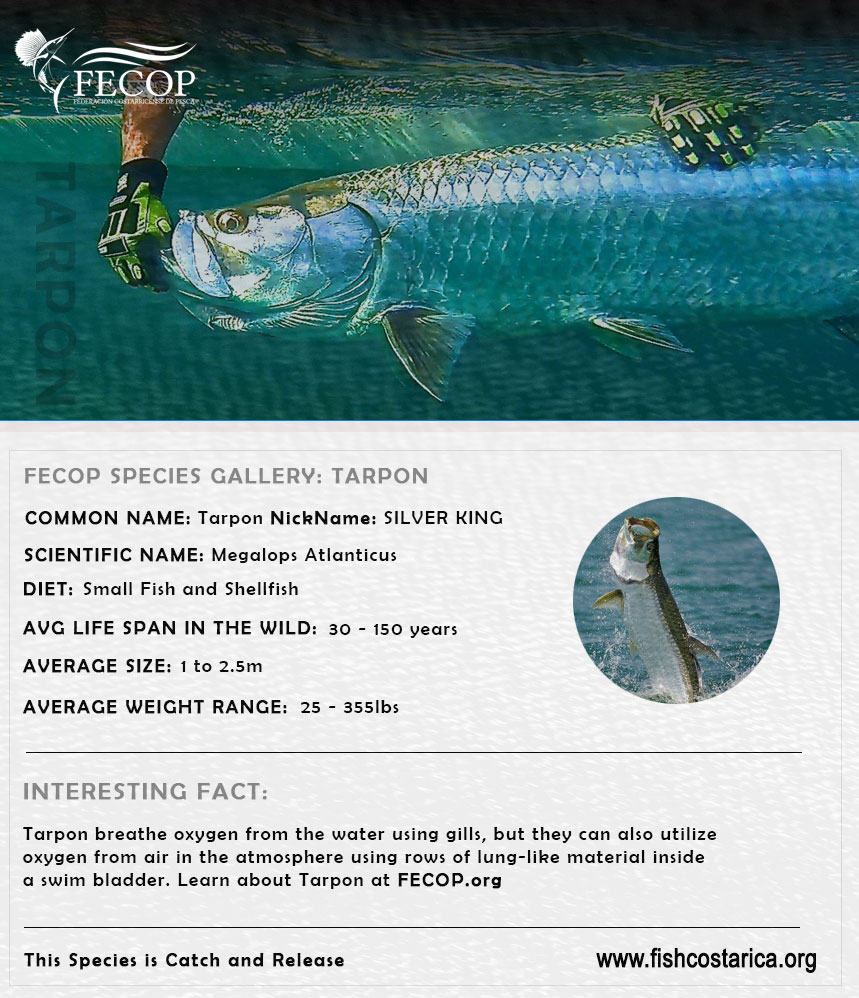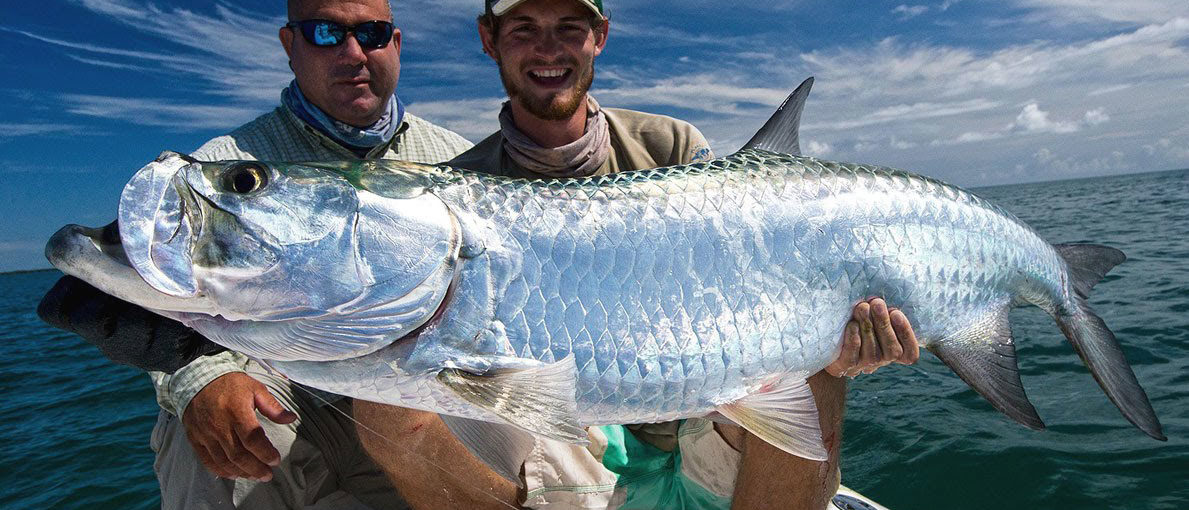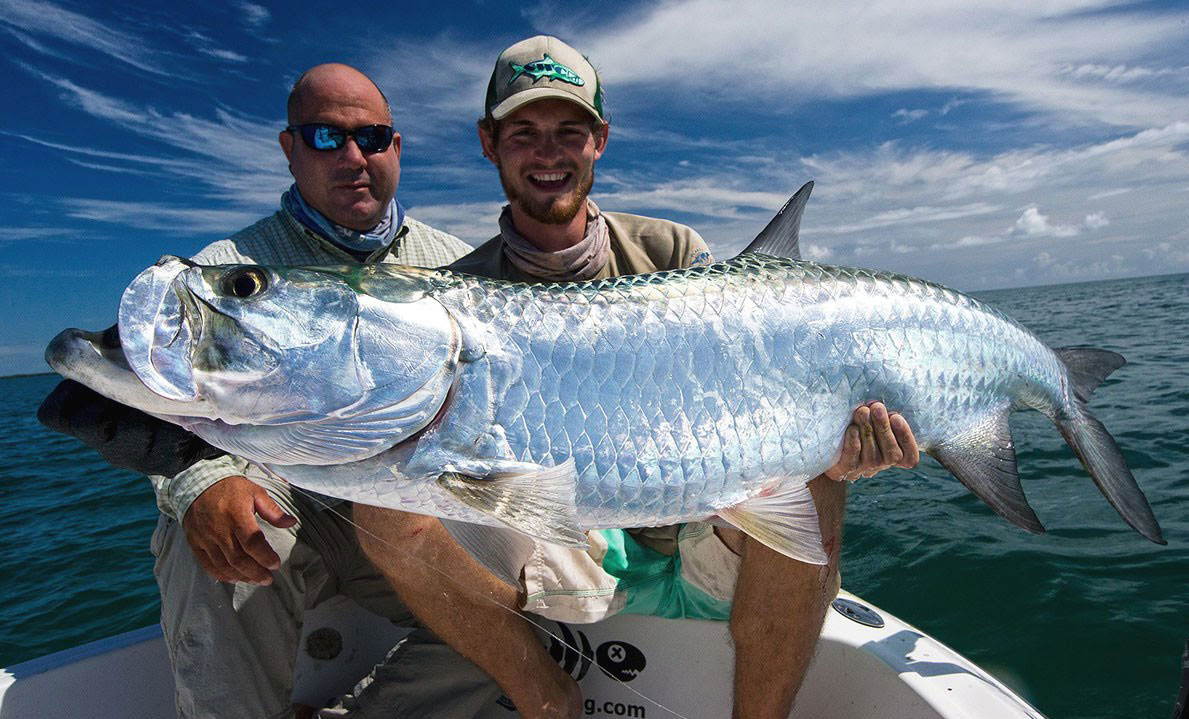Costa Rica Tarpon
Also see FECOP Article Top Ten Cool Tarpon Facts
Can I catch Tarpon in Costa Rica?
Yes, Costa Rica boasts some of the best tarpon fishing in the world, and they can be targeted year round. Historically the best tarpon fishing in Costa Rica is October and November.
Region: Costa Rica’s Caribbean Coast

From the IGFA Fish Database:
Valenciennes, 1846; MEGALOPIDAE FAMILY; also called silver king, cuffum
Occurs in warm temperate tropical and subtropical waters of the Atlantic Ocean. This coastal fish can be found both inshore and offshore. Because of its ability to gulp air directly into the air bladder by “rolling” at the surface, the tarpon is able to enter brackish and fresh waters that are stagnant and virtually depleted of oxygen. Such areas are relatively free of predators, thus offering a convenient refuge for the young.
The body is compressed and covered with very large scales. The lower jaw juts out and up. The teeth are small and fine, and the throat is covered by a bony plate. The dorsal fin consists of 12 16 soft rays (no spines) the last of which is greatly elongated. The back is greenish or bluish varying in darkness from silvery to almost black. The sides and belly are brilliant silver. Inland, brackish water tarpons frequently
They may shed up to 12 million eggs. The eggs hatch at sea and the eel like larvae drift in shore where they undergo a metamorphosis, shrinking to half the size previously attained and taking on the more recognizable features of the tarpon as they begin to grow again. Tarpon, bonefish, ladyfish and eels all undergo a similar leptocephalus stage, but the first three fish all have forked tails even at the larval state, whereas the eel does not. Tarpon grow rather slowly and usually don’t reach maturity until they are six or seven years old and about 4 ft (1.2 m) long.
Fishing methods are still fishing with live mullet, pinfish, crabs, shrimp, etc., or casting or trolling with spoons, plugs, or other artificial lures. The best fishing is at night when the tarpon is feeding. They are hard to hook because of their hard, bony mouths. Once hooked they put up a stubborn and spectacular fight, often leaping up to 10 feet out of the water. It was one of the first saltwater species to be declared a game fish
Tarpon are such a fascinating species it’s hard to put all the interesting facts about them in a single article here is a great article form the Tampa Bay Times
Tarpon Remain a Fascinating Species
There are some things you never grow tired of seeing — osprey diving for fish, dolphin herding mullet and tarpon cruising along the beach on a calm summer morning. You can keep your trout, snook and redfish. Nothing gets my blood pumping like the silver king of sportfish.
It is usually about this time of year, when the fish are thick in Tampa Bay, that I call Kathy Guindon, the state’s tarpon guru, to learn something new about what I consider the most interesting fish in the world.
Guindon, a biologist with the Florida Fish and Wildlife Conservation Commission, never lets me down. For starters, there are nearly 28,000 different fish, but only two species of tarpon.
“Fishes were in fact the first vertebrates on earth and date back to the Paleozoic era — this makes fish older than the dinosaurs,” she said.
So think about that this weekend if you rush out to see the new Jurassic World movie. The Jurassic and Triassic periods were part of the Mesozoic era that followed the Paleozoic. So while T-Rex may be long gone, we still have tarpon.
The species, which can grow to be 8 feet long and weigh nearly 300 pounds, is currently found in the estuaries and coastal waters throughout the Caribbean Sea and Gulf of Mexico; in the eastern Atlantic and along the western coast of Africa.
While the different species of fish have varied life spans ranging from a few weeks to more than 150 years, tarpon have pretty long lives.
“Scientists use a tarpon’s otolith (ear stone) to determine how old it is and count the rings on the otolith very much like counting tree rings to determine a tree’s age,” Guindon explained. “There was a 64-year-old tarpon that died in the Shedd Aquarium of Chicago in the 1990s.”
Tarpon in the wild can live well into their 50s. That’s pretty impressive considering that this species is on numerous predators’ menus. Fish-eating birds feed on young tarpon. Porpoises and alligators sometimes eat larger ones. But by far, the most dangerous predators are sharks. A big bull shark or great hammerhead can easily cut an adult tarpon in half with just one bite.
Although sportsmen prize tarpon for their acrobatic leaps and fighting ability, this species was once hunted for food by the indigenous people of Florida, and South and Central America.
“While tarpon are a catch-and-release fishery here in the USA, I know a researcher studying tarpon in Nigeria who told me she and her family eat tarpon for Christmas dinner,” Guindon said. “This is not acceptable practice here in Florida and that would be against Florida law.”
Tarpon are scavengers and will eat just about anything. Despite their large size, they feed on surprisingly small organisms, including mullet, ladyfish, pinfish, grunts, crabs, threadfin herring, scaled sardines and even catfish.
Another cool fact that is guaranteed to thrill your fishing buddies when the bite drops off: “Tarpon have amazing color vision with five types of cones cells in their eyes,” Guindon said. “They can see into the ultraviolet spectrum even further than birds and insects that have four types of cones cells in their eyes.”
In case you are wondering, humans only have three types of cone cells.
Throughout history, tarpon scales have been used as nail files, wall art and pulverized for medicinal purposes. Guindon participated in the last global stock assessment of tarpon in 2011 where she met a colleague from South America.
“She told me that in Brazil tarpon scales are pulverized into a powder and mixed into tea as it is believed to help with asthma,” Guindon said. “Sadly, the plucked tarpon is most often left to die.”
Perhaps my most favorite fun tarpon fact is this almost mammal-like adaptation: “Tarpon breathe in oxygen from the water using gills, but they can also utilize oxygen from air in the atmosphere,” Guindon explained. “They have for long rows of lung-like material inside a swim bladder that allows this to happen.”
Related Costa Rica Tarpon Fishing Articles
Are Tarpon Breeding in Costa Rica’s Pacific Waters
Amazing Tarpon Video from Costa Rica
This Fish Can Live Over 60 Years





















